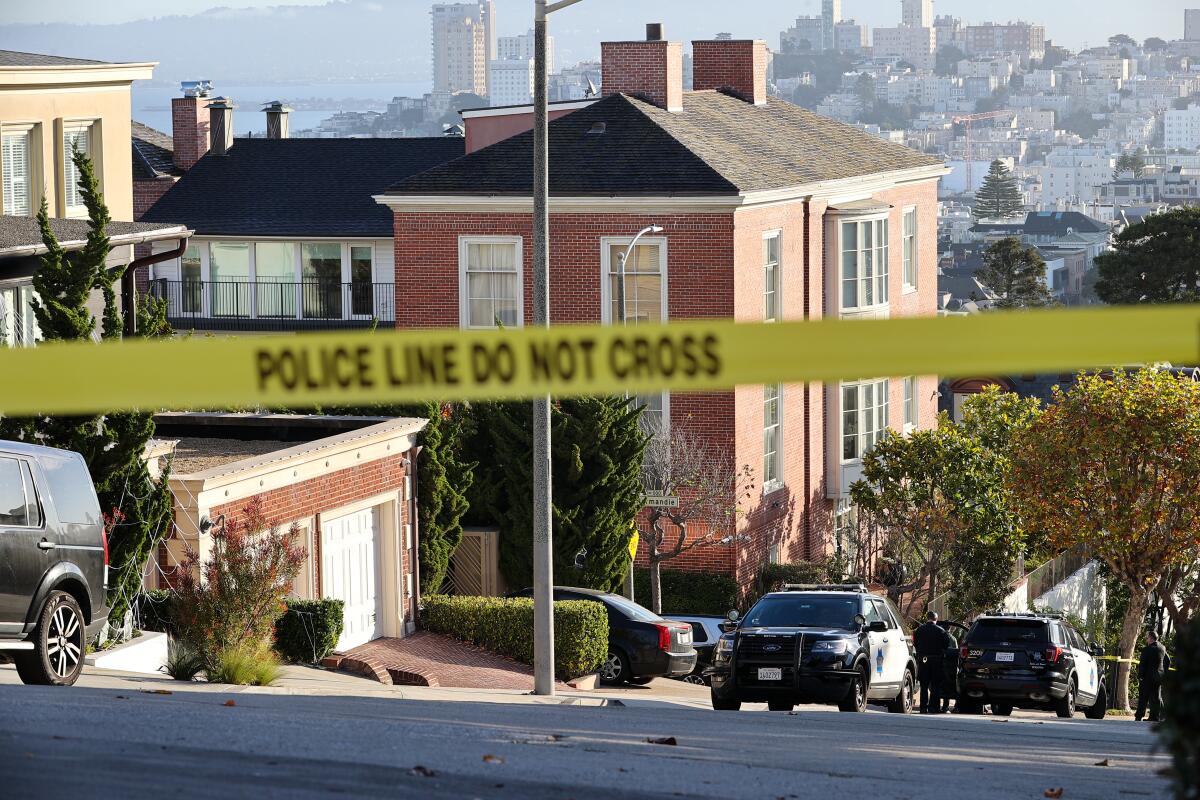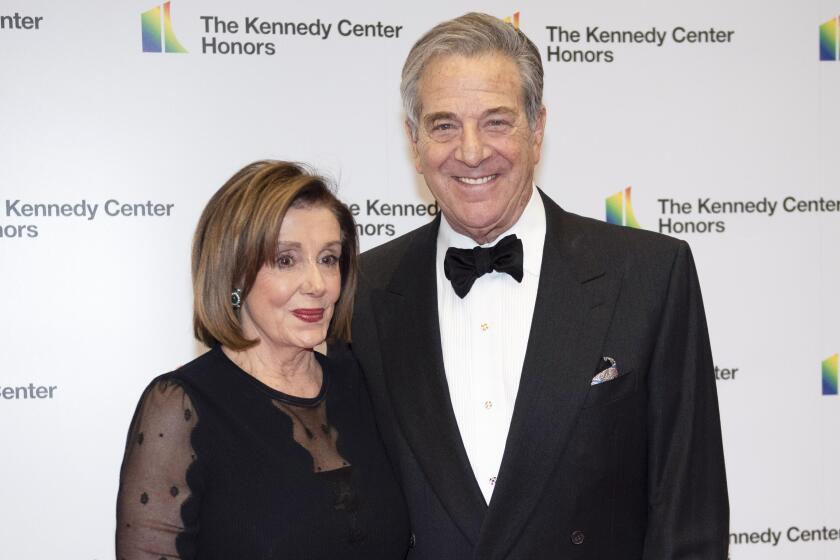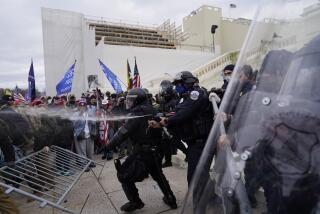‘We are a tinderbox’: Political violence is ramping up, experts warn

- Share via
In San Francisco’s tony Pacific Heights neighborhood, an intruder broke into House Speaker Nancy Pelosi’s home and violently attacked her husband. In a New York courtroom, a man pleaded guilty to threatening to kill California Democratic Rep. Eric Swalwell. In Washington, federal law enforcement warned that violent domestic extremism posed an elevated threat in the approaching midterm election.
All on the same day.
The targeting of the home of Speaker Pelosi, a Democrat who is second in line for the presidency, stood out on Friday for its brutality and sinister intent. But for many Americans, shock was tinged with a weary sense of inevitability. Far from a freak occurrence, the attack felt of a piece with the other threats and warnings publicized that day — the latest additions to the country’s growing sense of political menace, especially from the far right.
“Unfortunately, this is a continuation of at least a 2½-year-long established pattern of violence against elected officials and local officials, including poll workers, that has been steadily ramping up,” said Erica Chenoweth, a Harvard Kennedy School professor who studies political violence.
Politically motivated violence has ebbed and flowed throughout U.S. history. Currently, America is going through an upsurge in right-wing violence, according to researchers who track attacks and other incidents. They say today’s climate is comparable to that in the mid-1990s, when a similar wave of right-wing violence culminated in the 1995 bombing of the federal office building in Oklahoma City, which killed 168 people.
Incidents now range from the unprecedented — the Jan. 6, 2021, siege of the U.S. Capitol by supporters of President Trump who were trying to overturn his loss in the 2020 presidential election — to the more quotidian malice of telephone and email death threats.
There were 9,625 threats against members of Congress and their families last year, according to the Capitol Police — more than twice as many as in 2017. A joint project by the Anti-Defamation League and Princeton University tracked 400 incidents of harassment against local-level election, health and education officials in 43 states from January 2020 until mid-September this year.
The Nov. 8 midterm election is rife with potential targets for violence. In several parts of the country, right-wing organizations have mobilized poll watchers, who in some cases have confronted early voters. Members of one Arizona-based group, some in tactical gear, took photos of voters’ license plates at ballot drop boxes in the Phoenix area; a federal judge on Friday rejected a request to ban the observers’ activities, saying the 1st Amendment protected their right to assemble in public areas.
The attacker who confronted Nancy Pelosi’s husband Paul in their home yelled, ‘Where is Nancy?’ Read our full coverage.
The cumulative effect of these incidents is a bleaker national mood, polls show. In a YouGov poll in August, a strong majority of respondents said they believed political violence would increase in the coming years, and over half thought America would be less of a democracy a generation from now.
Over 40% of Americans think civil war is at least somewhat likely within the next decade, another YouGov poll that month indicated. One in five people who identified as strong Republicans said they believe civil war is very likely — more than any other political group.
The unsettled atmosphere “tends to influence what I call the signals among the noise — the very few individuals who are not just talking, but are going to take action and are going to be politically violent,” said Reid Meloy, a forensic psychologist who has worked as a consultant to the FBI’s Behavioral Analysis Unit. “Our work has been to focus on how do we detect the signals amid the noise.”
Over the last decade, politically motivated extremists, a majority of them right-wing, have killed over 400 people in the U.S., according to the Anti-Defamation League, which has tracked domestic political violence for 15 years. In 2021, political violence resulted in 29 deaths, according to the ADL’s most recent report.
The Center for Strategic and International Studies, which also tracks extremist violence, found that 2020 and 2021 had the most attacks since it began tracking incidents in 1994.
There was “a historically high level of both far-right and far-left terrorist attacks in 2021,” the bipartisan think tank’s researchers said, adding that “violent far-right incidents were significantly more likely to be lethal, both in terms of weapon choice and number of resulting fatalities.”
Robert Pape, a University of Chicago political scientist, likened the nation to a landscape full of flammable hazards during wildfire season.
“That combustible material doesn’t go off spontaneously — you need a lightning strike or cigar butt to trigger it,” Pape said.
“We are a tinderbox right now. ... The difference between the right and the left is you are getting lightning strikes on the right,” he continued. “It is just happening again and again.”
The “lightning strikes,” Pape said, are messages, explicit or implied, from prominent Republican politicians or media figures who use incendiary rhetoric and winking nods to conspiracy theories to stoke animosity against their ideological opponents.
Animus against Republicans has also led to danger and bloodshed. Louisiana Rep. Steve Scalise, the third-ranking House Republican, was gravely wounded in 2017 when a gunman opened fire at a practice for the GOP’s congressional baseball team. And in June, a California man armed with a pistol, a knife and tactical gear was arrested outside conservative Supreme Court Justice Brett M. Kavanaugh’s Maryland home; the man now faces charges of attempted murder.
Though some Democrats have been criticized for provocative language — Senate Majority Leader Charles E. Schumer warning conservative justices that they had “released the whirlwind” after they overturned Roe vs. Wade, for example — Pape said the party as a whole, especially President Biden, has been more forceful than Republicans in renouncing extremist rhetoric and actions.
“It’s one thing to condemn the violence,” Biden told reporters Saturday after he cast his ballot early in Delaware. “But you can’t condemn the violence unless you condemn those people who are arguing that the election is not real. ... The talk has to stop. That’s the problem.”
Republicans who said they strongly or very strongly believed that the 2020 election was stolen and that Biden is an illegitimate president — about 15% of the population — were “substantially more likely than others to consider violence usually or always justified” to achieve certain goals, according to a study by the Violence Prevention Research Program at UC Davis.
David DePape, 42, has been arrested in connection with a violent attack on U.S. House Speaker Nancy Pelosi’s husband, Paul Pelosi.
But there is some reason for optimism, according to recent research by the Chicago Project on Security and Threats, which Pape directs. The share of Trump supporters who think the use of force is justified to restore him to the presidency declined by 33% between April and September this year — a shift to roughly 13 million Americans justifying violence, down from 21 million.
The decline occurred over a period marked by several high-profile acts of ideological violence. Those included a mass shooting at a supermarket in Buffalo, N.Y., by a believer in the racist “Great Replacement” conspiracy theory who targeted Black shoppers; and an armed Trump supporter’s attempted attack on an FBI field office in Cincinnati a few days after agents searched the former president’s Mar-a-Lago estate for improperly retained classified documents.
The summer also saw concerted efforts to draw attention to the rising threat of political violence. The congressional hearings on the Jan. 6 insurrection publicly explored the extent of the violence that day, as well as the extensive lies by Trump and his allies about election fraud. And Biden dedicated an entire speech in Philadelphia to warning of peril to democracy.
The idea that political violence is inevitable “is wrong,” Pape said. “Naming and shaming, as has been done by the Jan. 6 committee and President Biden’s speeches, are likely diminishing support for violence. But we have a long way to go.”
Illinois Rep. Adam Kinzinger, a Republican who sits on the Jan. 6 panel, said Friday that the attack on Pelosi’s husband was a consequence of right-wing conspiracy theories.
“When you convince people that politicians are rigging elections, drink babies’ blood, etc., you will get violence. This must be rejected,” he wrote on Twitter.
And GOP Sen. Ben Sasse of Nebraska described the dynamic as “increasingly obvious: Disturbed individuals will easily succumb to conspiracy theories and rage — the consequences are bloody and un-American.”
Both men are stepping down from Congress.
Most GOP officials denounced Friday’s attack and offered thoughts and prayers without commenting on the broader political context.
The power of partisan reflexes was on display when Virginia Gov. Glenn Youngkin, a Republican, appeared to make light of the incident just hours after news of the assault broke.
“There’s no room for violence anywhere, but we’re going to send [Speaker Pelosi] back to be with him in California,” Youngkin said while campaigning for a GOP congressional candidate. His audience cheered.
The polarized reactions extended to partisan media. While mainstream and left-leaning outlets reported on radicalization on the right, conservative outlets such as Fox News painted the assault as evidence of out-of-control crime.
In one segment, Fox News host Laura Ingraham fretted that a “lone lunatic” would be used as justification to “silence conservative speech.” Her guest Kari Lake, the Republican candidate for Arizona governor, assured her that voters would see the incident as the fault of “leftist elected officials who have not enforced the laws.”
“The basic understanding about the context we’re living in ... is literally worlds apart,” said Chenoweth.
The Harvard political scientist said that bridging that divide will take time and deliberate effort, noting that research has shown that public figures using their platforms to condemn extremism and false conspiracy theories makes a difference.
“What we are experiencing is a democracy problem,” Chenoweth said. “The thing that could really help our democracy problem right now is for all our leaders, including our Republican leaders, to say over and over that this stuff has to stop.”
More to Read
Get the L.A. Times Politics newsletter
Deeply reported insights into legislation, politics and policy from Sacramento, Washington and beyond. In your inbox twice per week.
You may occasionally receive promotional content from the Los Angeles Times.













